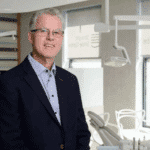By Tonya Johnson
Co-founder and CEO, Khamzat Asabaev says SoftSmile has been perfecting its technology to provide orthodontists with the tools needed to utilize skills, reduce cost, and usher in the next revolution in orthodontics.
SoftSmile, a software platform with a suite of features for orthodontists and their practices, announced the U.S. development of their aligner software technology. The software’s interface, designed to be user-friendly, enters the estimated $945 billion global orthodontic market, providing orthodontists the ability to create aligner treatment plans in-office that are then manufactured using advanced 3D printing technologies. Announcement of the launch took place at the AAO 2020: A Virtual Experience held by the American Association of Orthodontists.
“Our pride is in the biomechanics and machine learning algorithms, from every stage of the treatment process—whether it’s determining how many aligners are needed, or how the teeth should be moved,” explains Khamzat Asabaev, co-founder and chief executive officer of SoftSmile. Competing software brands on the market, he states, have fallen short in the staging process.

STANDING OUT IN THE CROWD
From a biomechanics perspective, Asabaev believes his company is ahead of the curve. He says that SoftSmile is the only company to consider the thickness of aligners. “In the manufacturing process, the thickness of aligners is always different,” he explains. “And, if the aligners are thinner or thicker than the standard scenario, it means that less or more force is applied, which can significantly affect the entire treatment process. That’s why many patients are often unhappy with the results.”
To address this issue, SoftSmile collaborated with the thermoformable material manufacturing company, Zendura, to retrieve and integrate data information into the SoftSmile math models that enables the system to precisely predict how thin or thick the aligner will be, and how much force should be applied.
The SoftSmile aligner software helps to create a 3D model of the orthodontic treatment plan, including the visualization of teeth roots and movement of the lower jaw during the treatment. It models optimized teeth movement and suggests, along with the knowledge and skill from the orthodontist, the exact number of aligners required for achieving the optimized result. The software, enhanced by AI, generates key aspects of a treatment plan. Machine learning algorithms automate the time-consuming processes and facilitate the final setup of aligned teeth based on orthodontic measurements, allowing the modeling software to create a digitally optimized treatment plan.

“Most of the results of the automated algorithms are suggested,” says Damian Gerikhanov, chief technology officer at SoftSmile, who wrote the entire software code. This allows doctors to make their own adjustments, on a case by case basis. He explains, “Our goal is to perfect the system, and the automated and machine learning models, which are constantly learning from the input of the user, so that the manual involvement is minimized.” Following the creation of the treatment plan, SoftSmile’s software automates 3D printing for orthodontists.
PRACTICING ORTHODONTISTS
SoftSmile is currently working with 3D printing company Carbon to integrate software and manufacturing so that distributed dental printing will become accessible to a wider group of orthodontists.
More than 100 orthodontists around the world have tested the technology—treating more than 1,000 people outside of the United States. “I was very impressed when I first started using the SoftSmile technology in my practice that specializes in the application of lingual braces,” says Roberto Stradi, DDS MSc in Caserta, Italy. “The learning curve for this technology was fairly minimal and the software was completely customizable, allowing me to remain in control and produce a successful result for my patients.”
In the United States, SoftSmile is backed by the Columbia Start Up Lab and cooperates with Columbia University in general, where Claudia L. Cruz, DDS, MPH, MS, also graduated. With a private practice in Virginia, she was typically seeing 35 patients a day, prior to the COVID-19 shelter-in-place regulations. She also serves as an Ad-Hoc Consultant in Oral Health Risk at Columbia University in New York City.

As an orthodontist professional for more than 20 years, she has used a variety of orthodontic treatments at her practice, but mostly aligners—including Invisalign and ClearCorrect. She received her first orthodontics certificate as a specialist from the Argentinean Society of Orthodontics in Buenos Aires. Then spent 10 years as a clinical assistant professor in the graduate program at the NYU Department of Orthodontics, and served as a consultant to the Bronx-Care Orthodontic Program. Impressed with the potential of SoftSmile’s “organic, user-friendly” product—especially when it comes to the application of lingual braces, that she often shied away from, she looks forward to doing the beta testing at her own practice as soon as possible. She is also looking to get the software into the hands of residents and younger colleagues, starting their careers.
“As orthodontists, we’ve been working with aligner software companies for the past 20 years, but we are still missing the sophisticated level of calculated data. The traditional means of orthodontic practice are no longer acceptable. We need to pay more attention to new technologies and the possibilities, because this is our future.”
Orthodontists can request to use the SoftSmile software in their practice on a trial basis, or download a demo version at SoftSmile.com.
“We have long been perfecting our technology,” Asabaev notes, “to provide orthodontists with the tools needed to fully utilize their skills, lower the cost of treatment plans for patients, and usher in the next revolution in orthodontics.”OP
Tonya Johnson is the associate editor of Orthodontic Products










